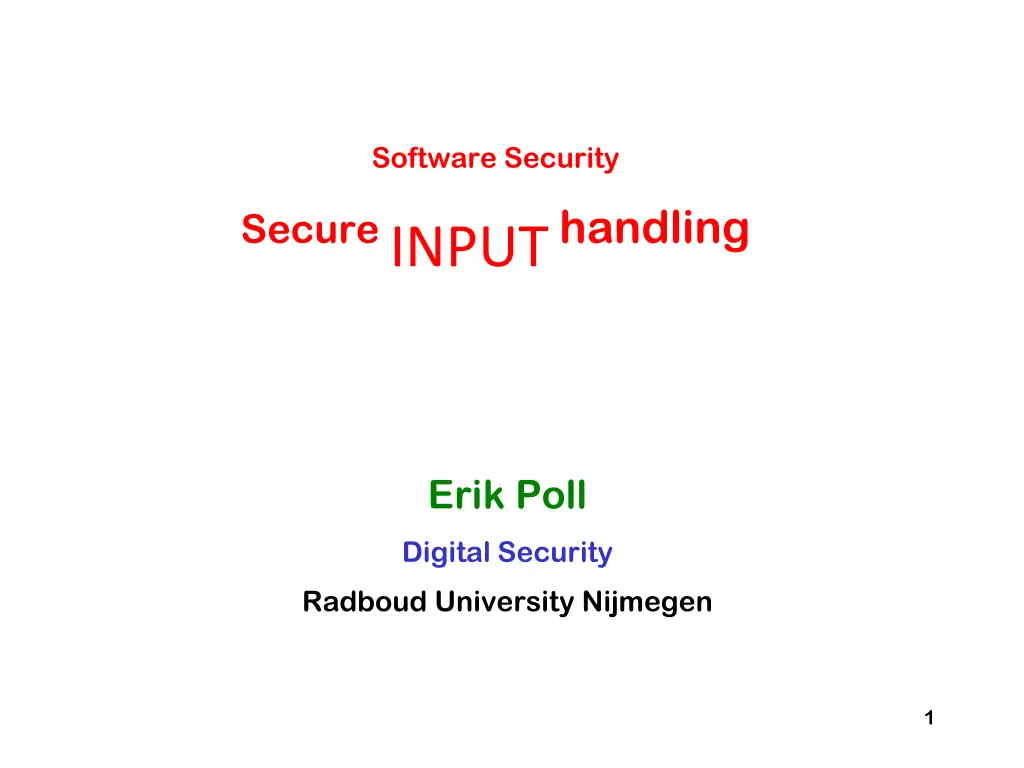
Understanding Web Security Best Practices
Explore key concepts in web security such as input handling, output encoding, XSS attacks, encoding for the web, and context-sensitive auto-escaping. Learn about common vulnerabilities and how to mitigate them effectively.
Download Presentation

Please find below an Image/Link to download the presentation.
The content on the website is provided AS IS for your information and personal use only. It may not be sold, licensed, or shared on other websites without obtaining consent from the author. If you encounter any issues during the download, it is possible that the publisher has removed the file from their server.
You are allowed to download the files provided on this website for personal or commercial use, subject to the condition that they are used lawfully. All files are the property of their respective owners.
The content on the website is provided AS IS for your information and personal use only. It may not be sold, licensed, or shared on other websites without obtaining consent from the author.
E N D
Presentation Transcript
Software Security Secure INPUThandling Erik Poll Digital Security Radboud University Nijmegen 1
Recap: two types of input problems 1. Buggy, insecure parsing a bug ! malicious input application eg buffer overflow in PDF viewer 2. Injection attacks: correct but unintended parsing (abuse of) a feature ! malicious input application back-end service eg SQL query 2
Output encoding OnlineShop.nl A B2 HTML renderer Output encoding needs be tailored to the context: for HTML renderer < > & script 3
XSS attack malicious input Response with malicious HTML content victim s browser 4
Encoding for the web HTML encoding (eg of <and > ) '<html> <body> <h1> ${name}'s Blog! </h1> URL encoding (eg of ?) ${description} <a href="https://ourdomain.nl/contact?user=${username}&lang=${lang}">Contact details for ${name} </a> <b onmouseover=alert("Welcome to ${firstname} s page")>Click here for a pop-up</b> </body> </html>' JavaString literal encoded (eg of ' and " ) 5
Some of the encodings for the web HTML encoding < > & replaced by > lt; & " ' Complication: encoding of attributes inside HTML tags may be different URL encoding aka %-encoding / ? = % # replaced by %2F %3F %3D %25 %23 space replaced by %20 or + Try this out with e.g. https://duckduckgo.com/?q=%2F+%3F%3D Complication: encoding for query segment different than for initial part, eg for / aka %2F JavaScript string literal encoding replaced by \ Eg this is a JS string with a \ in the middle Complication: JavaScript allows both ' and " for strings CSS encoding ... 6
Context-sensitive auto-escaping Context-sensitive auto-escaping web template engines try to figure out & insert the right encodings. E.g. Google Closure Templates, using context & encodings below Many template engines are not context sensitive! encodings inserted contexts (type qualifiers) [Samuel, Saxena, and Song, Context-sensitive auto-sanitization in web templating languages using type qualifiers, CCS 2017] 7
Extra complication: the DOM API JavaScript inside a web page can dynamically alter that web page using the DOM API (or do other interactions with other Web APIs) <html> <body> DOM API methods & fields to inspect & alter the web page <h1 id=title> ${name}'s Blog </h1> ... <script> let newName = getSomeData(); document.getElementById("title") .innerHTML = newName + "'s Blog!"; <script> </body> </html> Spot the XSS! A malicious newName could be Eve</h1><script someAttackScript();</script> // If newName is untrusted user input, it needs to be encoded, by the JS code: document.getElementById("title").innerHTML = htmlEscape(newName) + "'s Blog!" 8
DOM-based XSS attacks JavaScript code in a webpage is fed some malicious input (client- side!) and uses that input to change the webpage (client-side!) web server page.html bad page.html f(bad) f.js JS engine bad.html HTML renderer Malicious input can enter as 1) local user input, 2) URL parameters, 3) from the web server, 4) from another web server,... Server cannot validate or encode such inputs! (Except in case 3?) It has to be done by JS code inside the web page. 9
Escaping inside JavaScript Suppose we want JS code to create/change an HTML element elem into a link, labelled with a user-supplied name, that executes JS code createAlbum('name') when clicked, i.e. <a onclick="createAlbum('name')">name</a> Insecure JS code to do this elem.innerHTML = '<a onclick="createAlbum(\'' + name + '\')">' + name + '</a>'; Spot the XSS bug! As malicious name insert ' '; someAttackScript(); // How to escape name for the two different contexts here? var escapedName = goog.string.htmlEscape(name); // HTML-encoding var jsEscapedName = goog.string.escapeString(escapedName); // JS string literal encoding elem.innerHTML = '<a onclick="createAlbum(\'' + jsEscapedName + '\')">' + escapedName + '</a>'; Spot the XSS bug! 10
Spot the XSS bug! var escapedName = goog.string.htmlEscape(name); // HTML-encoding var jsEscapedName = goog.string.escapeString(escapedName); // JS string literal encoding elem.innerHTML = '<a onclick="createAlbum(\' ' + jsEscapedName + '\')">' + escapedName + '</a>'; Attack: enter malicious name HTML-escaped this becomes ');attackScript();// JS-escaped this remains ');attackScript();// So innerHTML becomes ');attackScript();// <a onclick= "createAlbum(' ');attackScript();// ')">');attackScript();//</a> The browser HTML-unescapes value of onclick attribute before evaluation as JS createAlbum(' ');attackScript();//') so attackScript(); will be executed [Example from Christoph Kern, Securing the Tangled Web, CACM 2014] 11
Preventing DOM-based XSS Writing JavaScript code that properly validates and encodes user input is hard! Modern web pages use a LOT of client side JS code, using large libraries, to provide fancy webpages The DOM API methods take strings as arguments, but for these strings it is hard to trace where they come from? (are they user input?) have they been validated? if so, how exactly? have been encoded? and if so, how exacty? Here we can use the safe builder approach! 12
API hardening for the DOM API (aka Trusted Types) Safe builder approach for JavaScript & DOM API use TypeScript rather than JavaScript use different types instead of just String, e.g. TrustedHtml, TrustedJavaScript, TrustedUrl, TrustedScriptUrl replace string-based DOM API with new typed API where operations take the right 'safe' type as parameter eg innerHTML takes TrustedHtml instead of a String Typing guarantees proper escaping & validation This is checked statically DOM API must be replaced & all JS code needs to be rewritten but ... this can be done incrementally, using old & new APIs side by side [https://github.com/WICG/trusted-types] [Released as a Chrome browser feature in 2019 https://developers.google.com/web/updates/2019/02/trusted-types] 13
Custom tweaks The Trusted Types / API hardening approach can be customised/extended to specific application: For example, Brightspace allows a restricted set of HTML tags in forum postings. To do this we would introduce introduce a custom type, SafeForumPosting, specify which functions require input of this type define custom operations to generate data of this type, Using validation and/or encoding. This code should be rigorously reviewed to make sure it is bullet-proof! 14
Yet another complication: different kind of URLs Suppose we let users add a link to jump to their homepage on another website <html> <body> <h1> ${name} 's Blog! </h1> ${description} ... <script> function goHome() { window.location.href = ${homeUrl} ;} </script> <button type="button" onclick="goHome()">Click here to go to ${name} 's home page!</button> ... Spot the XSS, if we allow users to specify any ${homeUrl} Browsers support pseudo URLs starting with javascript:, e.g. javascript:alert('Hi!'). Assigning such a URL to location.href will execute the script! User-supplied URLs have to be validated to check for javascript:URLs: server-side, of if its passed around in JS, client-side in JS code The Trusted Types API uses special type TrustedResourceUrl for sinks, such as location.href, where (pseudo) URLs can trigger execution of scripts 15
Conclusions 16
Languages & Parsing Parsing of many languages (formats, representations, ...) is where input problems happen, due to insecure parsing incorrect parsing, i.e. parsing differentials unintended parsing, i.e. injection attacks especially if languages are complex, poorly defined, and very expressive LangSec approach can prevent buggy - insecure or incorrect - incorrect parsing Safe builder approach, which generalises parameterised queries, can prevent injection attacks Injection possibilities become type errors 17
Validation vs Sanitisation/Encoding/Escaping Validation and sanitisation/encoding/escaping are two very different operations Output encoding makes more sense than input sanitisation, because encoding/sanitisation depends on context Ideally, don't validate but parse Ideally, use safe APIs that are immune to injection using types to enforce proper sanitisation & validation 18
Anti-pattern: string concatenation Standard recipe for security disaster: 1. concatenate several pieces of data, some user input, 2. pass the result to some API Note: string concatenation is inverse of parsing 19
Anti-pattern: strings The use of strings in a warning sign not just String but also char*, char[], StringBuilder, ... Strings are useful, because you use them to represent many things: eg. username, file name, email address, URL, HTML, This also make strings dangerous: 1. Strings are unstructured data that still needs to be parsed 2. The same string may be handled & interpreted in many possibly unexpected ways 3. Strings may or may not be validated or encoded, ... 4. A single string parameter in an API call often hides an expressive & powerful language 20
Pattern: Use Types Types can record & ensure various aspects of data origin of data, and hence the trust we have in it special mention: compile-time constants language/format it is intended for validated or not, and how exactly? encoded or not, and how exactly? preventing ambiguity & confusion 21
To read Wang et al., If It's Not Secure, It Should Not Compile: Preventing DOM- Based XSS in Large-Scale Web Development with API Hardening, ICSE'21, ACM/IEEE, 2021 Lectures notes on Secure Input Handling 22
Getting things wrong: double en/decodings Chrome used to crash on the URL http://%%30%30 %30 is the URL-encoding of the character 0 So %%30%30 is the URL-encoding of %00 %00 is the URL-encoding of null character So %%30%30 is a double-encoded null character Cause of the crash: code deep inside Chrome performs a second URL- decoding (as well-intended service to its client code?) and then some other code crashes on the resulting null character. How could this bug have been detected or prevented? Having encoded data around makes validation harder! Double encoding is a common way to get past validation checks. Note that encoding is the opposite of canonicalisation: it introduces different representations of the same data. Problem: keeping track of which data is encoded / may be decoded can be tricky in larger programs. Typing can help! 23






















